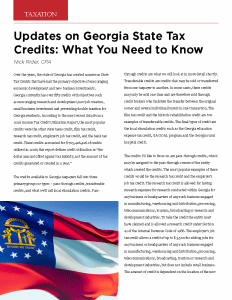Over the years, the state of Georgia has created numerous State Tax Credits that have had the primary objective of encouraging
economic development and new business investments. Georgia currently has over fifty credits with objectives such as encouraging research and development, new job creation, small business investment and preventing double taxation for Georgia residents. According to the most recent data from a 2016 Income Tax Credit Utilization Report, the most popular credits were the other state taxes credit, film tax credit, research tax credit, employer’s job tax credit, and the bank tax credit. These credits accounted for $705,426,426 of credits utilized in 2016; this report defines credit utilization as “the dollar amount offset against tax liability, not the amount of tax credits generated or created in a year.”
The credits available to Georgia taxpayers fall into three primary groups or types – pass-through credits, transferable credits, and what we’ll call local stimulation credits. Passthrough credits are what we will look at in more detail shortly. Transferable credits are credits that may be sold or transferred from one taxpayer to another. In some cases, these credits may only be sold one time and are therefore sold through credit brokers who facilitate the transfer between the original owner and several individual buyers in one transaction. The film tax credit and the historic rehabilitation credit are two examples of transferrable credits. The final types of credit are the local stimulation credits such as the Georgia education expense tax credit, GA GOAL program and the Georgia rural hospital credit.
The credits I’d like to focus on are pass-through credits, which may be assigned to the pass-through owners of the entity which created the credits. The most popular examples of these credits would be the research tax credit and the employer’s job tax credit. The research tax credit is allowed for having research expenses for research conducted within Georgia for any business or headquarters of any such business engaged in manufacturing, warehousing and distribution, processing, telecommunications, tourism, broadcasting or research and development industries. To take the credit the entity must have claimed and is allowed a research credit under Section 41 of the Internal Revenue Code of 1986. The employer’s job tax credit allows a credit of up to $3,500 for adding jobs for any business or headquarters of any such business engaged in manufacturing, warehousing and distribution, processing, telecommunications, broadcasting, tourism or research and development industries, but does not include retail business. The amount of credit is dependent on the location of the new job as well as the number of new jobs created. Less developed areas in the state allow for a larger credit while requiring fewer jobs be added, while more developed areas of the state offer a smaller credit amount and require a larger number of additional jobs to qualify.
Each of the credits discussed above, and others like them, could be used to offset the tax liability of the entity that created
the credit or assigned to the entity’s owners, in the event the entity which creates the credit is a pass-through entity such as a partnership or S-Corporation. The tax liability reduction due to credit utilization may be limited based on the type of credit used. Generally speaking, most credits can be used in conjunction with other credits to offset a Georgia taxpayer’s income tax liability fully. However, when using the research tax credit, a taxpayer may only reduce their income tax liability to 50 percent after all other credits have been used. The usage
of these credits varies depending on how the credit is created.
While encouraging economic development, the creation of so many credits in a relatively short amount of time has created issues processing credits at the Georgia Department of Revenue. In recent discussions with the Department of Revenue, one of the major issues discovered is the multiple ways in which the Department sees the claiming of credits on tax returns. These claims have become a significant issue when looking at credits assigned to the owners of pass-through entities such as partnerships and S-Corporations. When an individual receives a credit from a pass-through entity the credit must show a clear path from creation to final utilization. For example, when an S-Corporation creates a credit, the credit will be reported on Georgia Form 600S, Schedule 10. This schedule will show the details of the credit type, the dollar amount of credit, and then will show the amount of credit either used at the entity level or assigned to the owners. In cases where the credits are assigned to the shareholders, the assignment will be reported on Georgia Form 600S, Schedule 12. The shareholder will then report the credit on their GA Form 500, Schedule 2, showing the entity that created the credit and dollar amount assigned to them personally. When filing Georgia income tax returns, businesses, trusts, and individuals must report each level of creation and assignment of credits until the credits are used. In cases where a credit passes through a second level before getting to the individual taxpayer, for instance created in an S-Corporation, assigned to a trust, and then assigned to an individual, the individual must report the credit as coming from the trust, not the S-Corporation which created the credit. Each level of credit assignment must be reported for the Department of Revenue to process tax returns correctly. We recommend speaking with your clients about their opportunities to take advantage of the Georgia state tax credits; the long-term benefits can be rewarding for both practitioners and clients alike.




